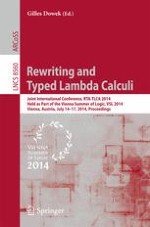This book constitutes the refereed proceedings of the Joint 25th International Conference on Rewriting Techniques and Applications, RTA 2014, and 12th International Conference on Typed Lambda-Calculi and Applications, TLCA 2014, held as part of the Vienna Summer of Logic, VSL 2014, in Vienna, Austria, in July 2014. The 28 revised full papers and 3 short papers presented were carefully reviewed and selected from 87 submissions. The papers provide research results on all aspects of rewriting and typed lambda calculi, ranging from theoretical and methodological issues to applications in various contexts. They address a wide variety of topics such as algorithmic aspects, implementation, logic, types, semantics, and programming.
